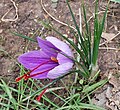
Saffron is a spice derived from the flower of Crocus sativus, commonly known as the "saffron crocus". The vivid crimson stigma and styles, called threads, are collected and dried for use mainly as a seasoning and colouring agent in food. The saffron crocus was slowly propagated throughout much of Eurasia and was later brought to parts of North Africa, North America, and Oceania.

Crocus is a genus of seasonal flowering plants in the family Iridaceae comprising about 100 species of perennials growing from corms. They are low growing plants, whose flower stems remain underground, that bear relatively large white, yellow, orange or purple flowers and then become dormant after flowering. Many are cultivated for their flowers, appearing in autumn, winter, or spring. The flowers close at night and in overcast weather conditions. The crocus has been known throughout recorded history, mainly as the source of saffron. Saffron is obtained from the dried stigma of Crocus sativus, an autumn-blooming species. It is valued as a spice and dyestuff, and is one of the most expensive spices in the world. Iran is the center of saffron production. Crocuses are native to woodland, scrub, and meadows from sea level to alpine tundra from the Mediterranean, through North Africa, central and southern Europe, the islands of the Aegean, the Middle East and across Central Asia to Xinjiang in western China. Crocuses may be propagated from seed or from daughter cormels formed on the corm, that eventually produce mature plants. They arrived in Europe from Turkey in the 16th century and became valued as an ornamental flowering plant.

Colchicum is a genus of perennial flowering plants containing around 160 species which grow from bulb-like corms. It is a member of the botanical family Colchicaceae, and is native to West Asia, Europe, parts of the Mediterranean coast, down the East African coast to South Africa and the Western Cape. In this genus, the ovary of the flower is underground. As a consequence, the styles are extremely long in proportion, often more than 10 cm (4 in). All species in the genus are toxic.

Colchicine is a medication used to treat gout and Behçet's disease. For gout, it is less preferred than nonsteroidal anti-inflammatory drugs (NSAIDs) or steroids. Other uses for colchicine include the management of pericarditis and familial Mediterranean fever. Colchicine is taken by mouth.
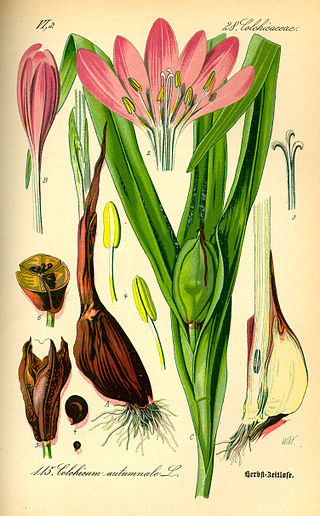
Colchicum autumnale, commonly known as autumn crocus, meadow saffron, naked boys or naked ladies, is a toxic autumn-blooming flowering plant that resembles the true crocuses, but is a member of the plant family Colchicaceae, unlike the true crocuses, which belong to the family Iridaceae. It is called "naked boys/ladies" because the flowers emerge from the ground long before the leaves appear. Despite the vernacular name of "meadow saffron", this plant is not the source of saffron, which is obtained from the saffron crocus, Crocus sativus – and that plant, too, is sometimes called "autumn crocus".
Autumn Crocus may refer to:
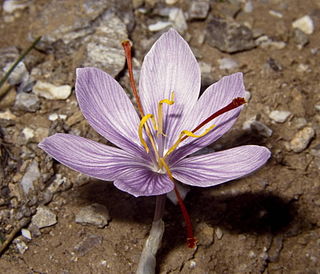
Crocus cartwrightianus is a species of flowering plant in the family Iridaceae, native to mainland Greece, Euboea, Crete, Skyros and some islands of the Cyclades. It is a cormous perennial growing to 5 cm (2 in). The flowers, in shades of lilac or white with purple veins and prominent red stigmas, appear with the leaves in autumn and winter.

Human cultivation and use of saffron spans more than 3,500 years and extends across cultures, continents, and civilizations. Saffron, a spice derived from the dried stigmas of the saffron crocus, has through history remained among the world's most costly substances. With its bitter taste, hay-like fragrance, and slight metallic notes, the apocarotenoid-rich saffron has been used as a seasoning, fragrance, dye, and medicine.

Colchicum speciosum is a species of flowering plant in the family Colchicaceae, native to mountainous areas of northern Turkey, the Caucasus and northern Iran. Growing to 18 cm (7 in) tall by 10 cm (4 in) wide, it is an herbaceous perennial growing from corms. C. speciosum blooms in the fall, producing reddish/violet flowers on stems up to 30 centimetres (12 in) tall without any leaves present. The strap-like leaves grow in the spring, then yellow, wither and die back as summer progresses. The flowers strongly resemble those of the crocus, the familiar spring-flowering bulb; hence the common name autumn crocus which is applied to this and other colchicum species. However the two genera belong to different families; and there is in fact an autumn-flowering crocus species, Crocus sativus, the source of the spice saffron. By contrast, all parts of Colchicum speciosum are toxic if ingested.

Colchicum × agrippinum is a species of flowering plant in the family Colchicaceae. It is considered to be a hybrid between C. variegatum and C. autumnale, and not a true species, although this is not certain. The genus and the species are commonly called autumn crocus, naked lady or meadow saffron.

Colchicum cilicicum, the Tenore autumn crocus, is a species of flowering plant in the Colchicaceae family. A bulbous perennial, it bears deep rose-lilac flowers in late summer, with barely any chequered pattern on the petals (tessellation). It has a very noticeable white stripe down the centre of each petal, which gives it a star-like appearance at the base. The flowers tend to stand up to weather better than other colchicum blooms. The flowers appear before the strap-like leaves, giving this and other colchicum species the common name “naked lady”. Although colchicums are called “autumn crocuses” they belong to a different family than true crocuses. There are in fact autumn-flowering species of crocus such as Crocus sativus, which is the source of the spice saffron. Colchicum cilicicum, by contrast, is toxic if eaten.
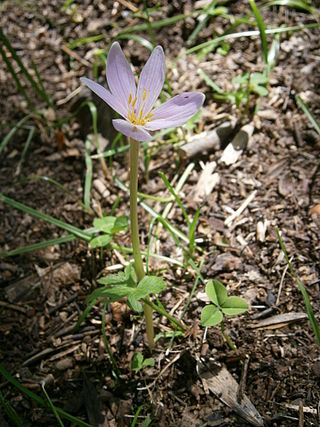
Colchicum alpinum, the alpine autumn crocus, is a corm-forming perennial with pale, delicate rosy-purple flowers, similar to C. autumnale but smaller. It is native to the Alps and the Appennini of Italy, Switzerland, France and Sicily, and cultivated as an ornamental in other regions.

Cytotaxonomy is the classification of organisms using comparative studies of chromosomes during mitosis.

Colchicum ritchii, or the Egyptian autumn crocus, is a plant species native to the southeastern Mediterranean east to the Arabian Peninsula.
Saffron is one of the world's most expensive spices by weight due to its difficulty to harvest. Saffron consists of stigmas plucked from the vegetatively propagated and sterile Crocus sativus, known popularly as the saffron crocus. The resulting dried "threads" are distinguished by their bitter taste, hay-like fragrance, and slight metallic notes. The saffron crocus is unknown in the wild; its most likely precursor, Crocus cartwrightianus, originated in Crete or Central Asia; The saffron crocus is native to Southwest Asia, and is believed to have been first cultivated in Iran. Greece, Turkey, and Kashmir (India) have also been suggested as possible sites of origin.
"Saffron, for example, was once less regarded than it is today because the crocus from which it is extracted was not particularly mysterious. It flourished in European locations extending from Asia Minor, where it originated, to Saffron Walden in England, where it was naturalised. Only subsequently, when its labour-intensive cultivation became largely centred in Kashmir (India), did it seem sufficiently exotic to qualify as one of the most precious of spices."

Colchicum stevenii, or Steven's meadow saffron, is a species of flowering plant in the family Colchicaceae. Hebrew: סתוונית היורה, Arabic: سَراجُ الغولة, سُورَنْجان

Crocus ochroleucus is species of flowering plant in the Iridaceae family. It is a cream-colored crocus native to Lebanon, Palestine and Syria.
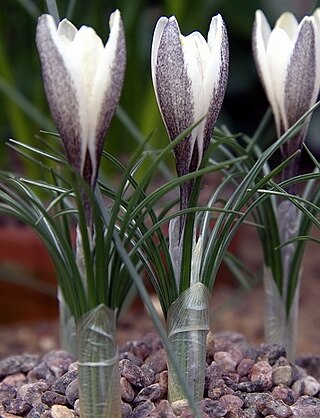
Crocus alatavicus is a species of flowering plant in the genus Crocus of the family Iridaceae. It is a cormous perennial native to Kazakhstan, Kyrgyzstan, Tajikistan, Uzbekistan, and Xinjiang.
Crocus bertiscensis is a species of flowering plant growing from a corm, native to the northern Albanian Alps.



